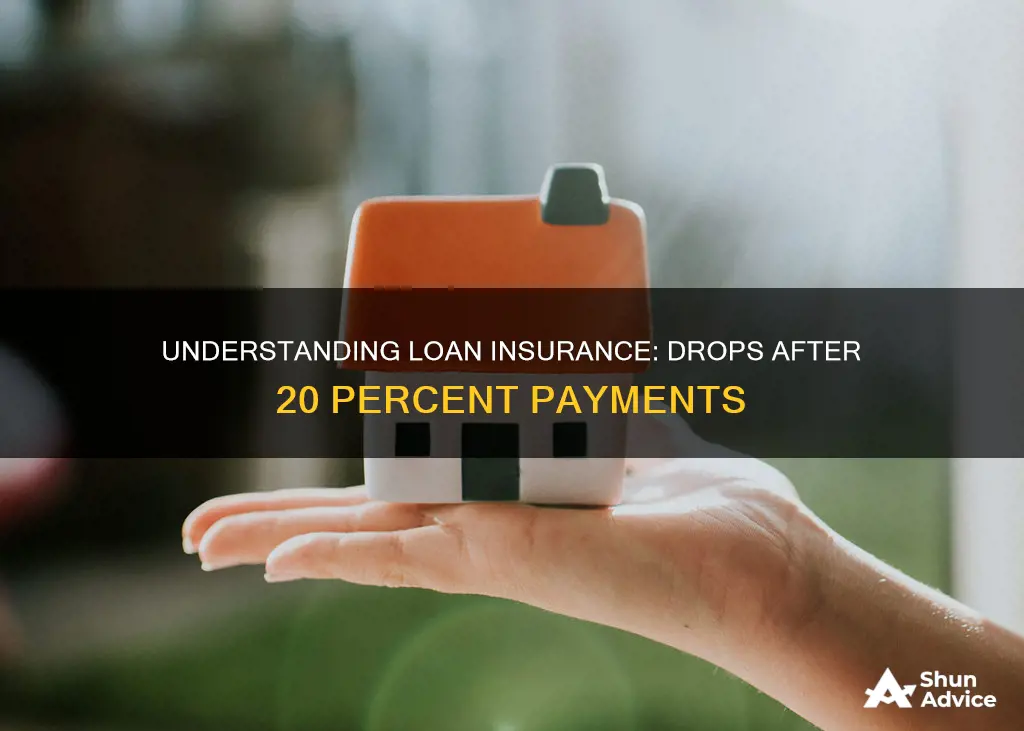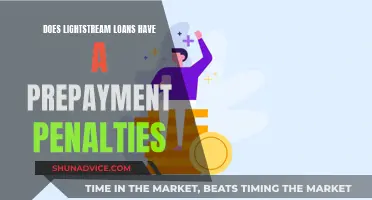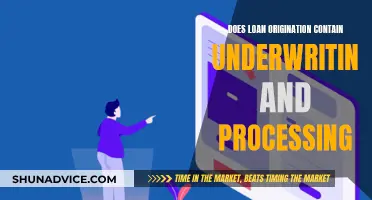
Private mortgage insurance (PMI) is an added cost homebuyers must pay if they purchase a home with a down payment of less than 20%. This insurance protects the lender in case the borrower defaults on their loan. While it can be beneficial for those looking to buy or refinance a home, it can also add a significant amount to the overall cost of the loan. So, does loan insurance drop when 20 percent equity is reached? The answer is yes, but it is not always easy to get rid of PMI, and it depends on the type of loan.
| Characteristics | Values |
|---|---|
| When does loan insurance drop? | When the loan balance drops to 78% of the home's purchase price or 80% loan-to-value ratio. |
| Who does it apply to? | Homebuyers who put down less than 20% on a conventional loan. |
| What is the insurance called? | Private Mortgage Insurance (PMI) |
| What does it protect against? | It protects the lender in case the borrower defaults on the loan. |
| How much does it cost? | PMI typically costs between 0.5% to 1% of the entire loan amount annually. |
| Can it be avoided? | Yes, by using a piggyback second mortgage on top of a purchase mortgage or by using gift money to reach the 20% threshold. |
| Can it be removed early? | Yes, by refinancing, a reappraisal, or by paying down the mortgage faster. |
What You'll Learn

Private mortgage insurance (PMI)
PMI can be paid in several ways. Sometimes, it is paid as a one-time upfront premium at closing. It can also be paid with both upfront and monthly premiums, or solely through monthly premiums. The monthly premium is added to the monthly mortgage payment.
PMI can be avoided by making a 20% down payment. It can also be avoided by obtaining a piggyback second mortgage, also known as an 80-10-10 loan, on top of the purchase mortgage. In this strategy, the buyer makes a 10% down payment and takes out two mortgages that cover the other 90%. The first loan covers 80% of the total value of the property, and the second loan, or piggyback loan, covers the remaining 10%.
PMI is usually automatically cancelled when the borrower's equity reaches 22%. However, the borrower can request to cancel PMI when their mortgage balance reaches 80% of their home's value. The lender must cancel PMI when the balance reaches 78% of the home's value or when the loan term is at its halfway point, whichever comes first.
Lendly's Weekend Loan Availability: Everything You Need to Know
You may want to see also

PMI cancellation requirements
Private mortgage insurance (PMI) is an added cost homebuyers must pay if they purchase a home with a down payment of less than 20%. This kind of insurance protects the lender in case the borrower defaults.
The Homeowners Protection Act of 1998 (HPA) requires that mortgage lenders or servicers automatically cancel PMI when the mortgage's loan-to-value (LTV) ratio reaches 78% of the home's purchase price, or when the loan term is at its halfway point, whichever comes first. You don't have to wait for the automatic cancellation, though. You can ask for it as soon as your balance hits 80%, as long as you're in good standing with your payments.
To estimate the amount your mortgage balance needs to reach to be eligible for PMI cancellation, multiply your home's purchase price by 0.80. You can prepay your mortgage in several ways, including biweekly payments, an additional payment each year, or in one lump sum at any time. Check with your lender or servicer to ensure those extra payments go to the loan's principal, not your next payment or interest.
Some lenders require you to maintain a PMI contract for a designated period, so even if you have met the 20% threshold, you may still be obligated to keep paying for the mortgage insurance. Read the fine print of your PMI contract to determine if this is the case for you. Usually, PMI isn't automatically canceled until your equity hits 22%.
Mortgages through the Federal Housing Administration (FHA) or Department of Veterans Affairs (VA) have different requirements. If your lender is paying for your mortgage insurance, different rules apply. You have the right to ask your servicer to cancel PMI on the date the principal balance of your mortgage is scheduled to fall to 80% of the original value of your home. The first date you can make the request should appear on your PMI disclosure form, which you received along with your mortgage. If you can't find the disclosure form, contact your servicer. You can ask to cancel PMI ahead of the scheduled date if you have made additional payments that reduce the principal balance of your mortgage to 80% of the original value of your home.
Loan Depot's HELOC Options: What You Need to Know
You may want to see also

Strategies to avoid PMI
Private mortgage insurance (PMI) is an added cost that many homebuyers face when their down payment is less than 20%. It is a type of insurance that protects the lender in case the borrower defaults on the loan. The simplest way to avoid PMI is to make a down payment of 20% or more. However, not everyone can afford to do this. Here are some alternative strategies to avoid PMI:
- Piggyback loan: This strategy involves using two mortgages so that neither mortgage is for more than 80% of the home's value. For example, you can take out one loan for 80% of the total value of the property and a second loan, known as a piggyback loan, for the remaining 10%. It should be noted that the terms of a piggyback loan can be risky, with some being adjustable-rate loans or due in 15-20 years. Additionally, the second credit will often have a higher interest rate and should be repaid as soon as possible.
- VA loans: VA loans are backed by the Department of Veterans Affairs and are available to current and veteran service members and eligible spouses. They don't require a down payment or mortgage insurance, although there is a one-time funding fee.
- USDA loans: USDA loans are backed by the U.S. Department of Agriculture and are zero-down mortgages for lower- and moderate-income buyers in designated rural and suburban areas.
- FHA loans: While FHA loans don't have PMI, they do require an upfront mortgage insurance premium (UFMIP) and an annual mortgage insurance premium (MIP) that must be paid monthly, regardless of your down payment amount.
- Lender-paid mortgage insurance: In some cases, lenders will pay for PMI, usually in exchange for charging a higher interest rate on the mortgage. This is known as lender-paid mortgage insurance.
- Gift money: Lenders will usually allow gift money to be used for a down payment as long as it is truly a gift and not a loan in disguise. The person giving the gift must provide a "gift letter" to the lender, affirming that the money is a gift and is not expected to be repaid. Gifts from immediate family members are usually acceptable, while gifts from more distant relatives, friends, or employers may not be.
LendingClub Weekend Loan Approvals: What You Need to Know
You may want to see also

Mortgage insurance premiums (MIP)
MIP is paid by homeowners who take out loans backed by the FHA. Your FHA loan MIP will involve two payments: an upfront premium and an additional annual payment. The amount you pay for both depends on your loan amount. The upfront MIP payment is due when you close on your FHA loan. Alternatively, it can be added to the balance of the loan. The upfront payment is only due once unless you refinance or take on another FHA loan in the future. Your annual mortgage insurance premium costs will vary depending on your loan amount and whether your base loan amount is greater than, less than, or equal to $726,200, according to the FHA.
With a 10% or larger down payment on an FHA loan, you’ll pay MIP for the first 11 years. With less than 10%, MIP lasts the entire loan term. Most lenders add MIP to your monthly mortgage payment. To calculate your monthly cost, divide the annual MIP by 12.
For loans originated after June 3, 2013: If you made a down payment of less than 10% of the home's value at loan origination, you must pay the MIP for the life of the loan. The only way to remove the qualified mortgage insurance (MIP) on an FHA loan is to refinance it into a non-FHA product.
Lending Club's Real Estate Loan Options: What You Need to Know
You may want to see also

Lender-paid mortgage insurance
LPMI is available on consumer-friendly loan products with low or no down payments, such as fixed-rate mortgages and adjustable-rate mortgages with limited rate adjustments. It differs from traditional borrower-paid mortgage insurance (BPMI or PMI) in that the lender pays the premium, resulting in a slightly higher interest rate for the borrower. With BPMI, the borrower pays the premium separately through a monthly escrow. LPMI can lower the overall cost of mortgage insurance while providing protection from default losses, which is often needed for lenders and investors to make low-down-payment mortgage loans.
One benefit of LPMI is that it results in a lower monthly payment than other mortgage insurance options, such as "piggyback" mortgage structures. A piggyback mortgage involves obtaining a second mortgage to reduce the first mortgage's loan-to-value ratio to 80%, eliminating the need for mortgage insurance. However, LPMI may result in higher overall costs since you pay a higher interest rate for the life of the loan. Your interest rate and costs will be higher than without LPMI, but you won't pay monthly mortgage insurance premiums, so your total payment might be cheaper.
To decide if LPMI is the best option, consider the benefits of having your mortgage lender cover your mortgage insurance. You can calculate the monthly principal and interest (P&I) with and without LPMI to compare costs. Additionally, you can request a monthly mortgage insurance quote from your lender, which will depend on your credit score and down payment. It's also important to note that LPMI cannot be cancelled unless you refinance or pay off your loan. Therefore, it's a long-term commitment built into your mortgage interest rate.
Understanding Prepayment Penalties in Loan Closing Disclosures
You may want to see also
Frequently asked questions
PMI stands for Private Mortgage Insurance. It is an added cost homebuyers must pay if they purchase a home with a down payment of less than 20%.
You can avoid paying PMI by making a 20% down payment. You can also use gift money to reach the 20% threshold. Lenders will usually allow gift money to be used for a down payment, but there are some stipulations. The gift money must be a gift and not a loan. The person giving the gift must provide a "gift letter" to the lender, affirming that the money is a gift and not a loan.
Yes, you can request to cancel PMI before you reach 20% equity in your home. You can find the date that your loan balance reaches 80% on your PMI disclosure form. If you don't have this form, you can request it from your servicer.
Your servicer must automatically terminate PMI when your principal balance is scheduled to reach 78% of the original value of your home. For 30-year loans, the midpoint is after 15 years.







